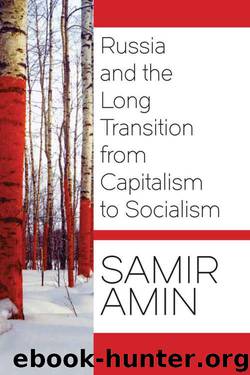Russia and the Long Transition from Capitalism to Socialism by Samir Amin

Author:Samir Amin [Amin, Samir]
Language: eng
Format: epub
Publisher: Monthly Review Press
Published: 2016-07-01T04:00:00+00:00
LENIN, BUKHARIN, AND STALIN’S EQUIVOCATIONS are understandable, then, because they were faced with the challenges presented by the agrarian question and the aggressiveness of the Western powers. In theoretical terms, there were U-turns from one extreme to the other. Sometimes a determinist attitude inspired by the phased approach inherited from earlier Marxism (first the bourgeois democratic revolution, then the socialist one) predominated; sometimes it was a voluntarist approach (political action would allow a leap-over stage). Finally, from 1930 to 1933, Stalin chose rapid industrialization and armament (and this choice was not without some connection to the rise of fascism). Collectivization was the price of that choice. Here again, we should refrain from making too hasty conclusions: all socialists of the time (and even more so, the capitalists) shared Kautsky’s analyses on this point and were convinced that the future belonged to large-scale agriculture. The idea that the modernized family farm is more efficient than large-scale farms would have to wait a long time before being accepted. Agronomists (particularly those of the French school) understood before economists that the extreme division of labor in the industrial model was not suitable in agriculture. The farmer is faced with the requirements of a variety of tasks that are difficult to predict.
The break in the worker-peasant alliance implied by the choice of collectivization was the origin of the abandonment of revolutionary democracy and the autocratic turn.
Would Trotsky have done better? In my opinion, he would certainly not have. His attitude toward the revolt of the Kronstadt sailors and his later equivocations demonstrate that he was no different than the other Bolshevik leaders in government. But, after 1927, living in exile and no longer having responsibility for managing the Soviet state, he could delight in endlessly repeating the sacred principles of socialism. He became like many academic Marxists who have the luxury of asserting their attachment to principles without the need to be concerned about being effective in transforming reality. There are pleasant exceptions among Marxist intellectuals who, without having had responsibilities in the leadership of revolutionary parties, let alone revolutionary states, have nonetheless remained attentive to the challenges confronted by state socialisms (such as Baran, Sweezy, Hobsbawm, and others).
The Chinese communists appeared later on the revolutionary stage. As a result, Mao was able to learn from Bolshevik equivocations. China was confronted with the same problems as Soviet Russia: revolution in a backward country, the necessity of including the peasantry in revolutionary transformation, and the hostility of the imperialist powers. But Mao saw more clearly than Lenin, Bukharin, and Stalin. Yes, the Chinese Revolution was anti-imperialist and anti-feudal. But it was not bourgeois democratic; it was popular democratic. The difference is important: a popular democratic revolution necessitates maintaining the worker-peasant alliance in the long run. That allowed China to avoid the fatal error of forced collectivization and instead made all agricultural land state property, gave the peasantry equal access to use of this land, and renovated family farms. Thus, Mao gave a new response to
Download
This site does not store any files on its server. We only index and link to content provided by other sites. Please contact the content providers to delete copyright contents if any and email us, we'll remove relevant links or contents immediately.
| Anthropology | Archaeology |
| Philosophy | Politics & Government |
| Social Sciences | Sociology |
| Women's Studies |
The Secret History by Donna Tartt(18168)
The Social Justice Warrior Handbook by Lisa De Pasquale(11956)
Thirteen Reasons Why by Jay Asher(8457)
This Is How You Lose Her by Junot Diaz(6443)
Weapons of Math Destruction by Cathy O'Neil(5837)
Zero to One by Peter Thiel(5495)
Beartown by Fredrik Backman(5366)
The Myth of the Strong Leader by Archie Brown(5241)
The Fire Next Time by James Baldwin(5022)
How Democracies Die by Steven Levitsky & Daniel Ziblatt(4965)
Promise Me, Dad by Joe Biden(4909)
Stone's Rules by Roger Stone(4865)
100 Deadly Skills by Clint Emerson(4694)
A Higher Loyalty: Truth, Lies, and Leadership by James Comey(4554)
Rise and Kill First by Ronen Bergman(4547)
Secrecy World by Jake Bernstein(4390)
The David Icke Guide to the Global Conspiracy (and how to end it) by David Icke(4384)
The Farm by Tom Rob Smith(4328)
The Doomsday Machine by Daniel Ellsberg(4248)
